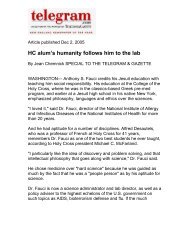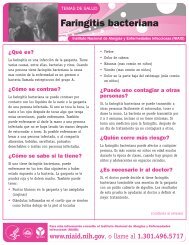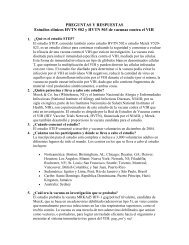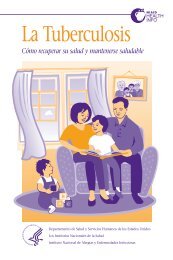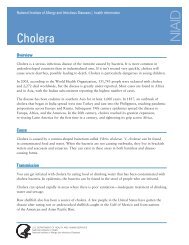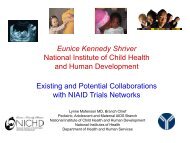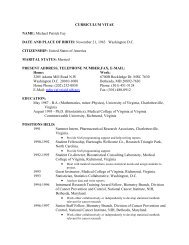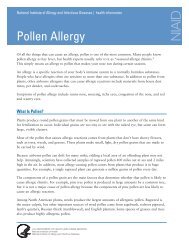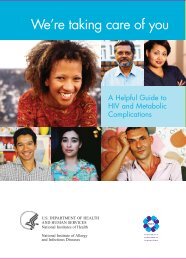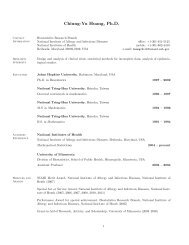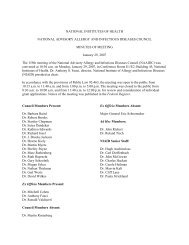Sample Grant Application - NIAID - National Institutes of Health
Sample Grant Application - NIAID - National Institutes of Health
Sample Grant Application - NIAID - National Institutes of Health
You also want an ePaper? Increase the reach of your titles
YUMPU automatically turns print PDFs into web optimized ePapers that Google loves.
Principal Investigator/Program Director (Last, first, middle): Dow, Steven, W<br />
3. Research Strategy<br />
(a) Significance. Burkholderia pseudomallei (Bp) infection is a Gram-negative bacterial pathogen<br />
that normally survives as a saprophyte in soil and water, but is also capable <strong>of</strong> infecting most<br />
mammals and causing serious infections (1-5). Bp infection is a major cause <strong>of</strong> bacterial sepsis and<br />
chronic disseminated infections (meliodosis) in humans in Thailand and northern Australia (4-8). The<br />
fatality rate for patients with Bp infection, even with prompt and aggressive treatment, still ranges from<br />
20% to over 50%. Moreover, Bp is an emerging pathogen and infections have been increasingly<br />
reported in many regions <strong>of</strong> the world, including Central and South America (9-13). In fact, Bp<br />
infection is now considered endemic in regions <strong>of</strong> China and India, and in Brazil (11, 12, 14).<br />
Infections with Bp are particularly dangerous because the organism is intrinsically resistant to many<br />
antimicrobials, can persist for years in the soil and in water, and can cause a wide array <strong>of</strong> clinical<br />
symptoms, ranging from acute sepsis, to chronic recurrent infection, to clinically silent infection (5-8,<br />
15-17). Meliodosis is also an increasing problem in travelers who have visited regions <strong>of</strong> the world<br />
where Bp is endemic(18). Thus, Bp is dangerous bacterial pathogen with high potential for spread into<br />
new regions <strong>of</strong> the world including the U.S. via deliberate or accidental introduction in soil, food, or<br />
water.<br />
Currently Bp is not considered a primary enteric pathogen for infection <strong>of</strong> humans. At present,<br />
infection with Bp is presumed to occur following inhalation or cutaneous inoculation, though the actual<br />
link between cutaneous exposure and infection is weak (Dr. Sharon Peacock, see Letter <strong>of</strong> Support).<br />
Thus, current treatment and prevention efforts for human meliodosis do not consider the impact <strong>of</strong> oral<br />
infection or persistent fecal carriage and shedding <strong>of</strong> the organism (5, 7, 8). There is however<br />
epidemiological evidence to suggest that oral infection with Bp does occur in humans. For example,<br />
outbreaks <strong>of</strong> meliodosis in villages in Indonesia have been linked directly to drinking water supplies<br />
contaminated with Bp, which can survive for years in water(19). Infections with Bp increase<br />
significantly during times <strong>of</strong> greater exposure to very wet conditions (eg, rice farming during the<br />
monsoon season), which would be consistent with oral exposure to a water borne agent (20-22).<br />
Outbreaks <strong>of</strong> meliodosis have also been associated with tsunami events (23, 24). In addition, patients<br />
with meliodosis have been misdiagnosed as having typhoid (enteric fever)(25). In fact, clinical<br />
observations (Dr. Peacock, personal communication) suggest that oral infection may be a much more<br />
important route <strong>of</strong> infection with Bp in humans than previously assumed. Since Bp can persist in water<br />
or soil for years, enteric infection <strong>of</strong> humans with Bp would have major public health consequences(26,<br />
27).<br />
Virtually nothing is known regarding enteric infection with Bp. Development <strong>of</strong> a new animal<br />
model <strong>of</strong> enteric Bp infection would therefore be valuable for several reasons. For one, a mouse<br />
enteric Bp model would be essential for helping understand the pathogenesis <strong>of</strong> enteric meliodosis in<br />
humans. A new mouse model <strong>of</strong> an enteric Bp infection would also add an important new animal<br />
model for study <strong>of</strong> enteric pathogens in general. From a clinical perspective, an enteric Bp infection<br />
model in mice would also be critical for development <strong>of</strong> new vaccines for Bp and for development <strong>of</strong><br />
new antimicrobial treatment and prevention strategies.<br />
(b) Innovation. We have spent several years developing mouse models <strong>of</strong> Burkholderia infection for<br />
evaluating new immunotherapeutic approaches to treatment and for investigating the<br />
immunopathogenesis <strong>of</strong> pulmonary infection with B. mallei and B. pseudomallei (28-30). In the course<br />
<strong>of</strong> these studies, we made the unexpected observation that mice could be easily infected with Bp<br />
following oral inoculation and remain persistently infected and undergo persistent fecal shedding <strong>of</strong> Bp.<br />
We have determined mouse strain differences in susceptibility to oral infection with Bp. It also became<br />
clear from our studies that the ability to cause enteric infection was not only a property <strong>of</strong> laboratory<br />
adapted strains <strong>of</strong> Bp. These preliminary data therefore provide compelling new evidence that Bp is<br />
an enteric pathogen, a fact not previously appreciated by others in the field. Thus, we have now<br />
developed a new mouse model <strong>of</strong> enteric infection with Bp that has the potential to substantially alter<br />
the current Bp infection paradigm.<br />
Our access to a collection <strong>of</strong> over 30 clinical isolates <strong>of</strong> Bp obtained from patients in Thailand<br />
and Australia provides a key resource for these studies. This panel <strong>of</strong> Bp isolates, provided by our<br />
Research Strategy Page 31



